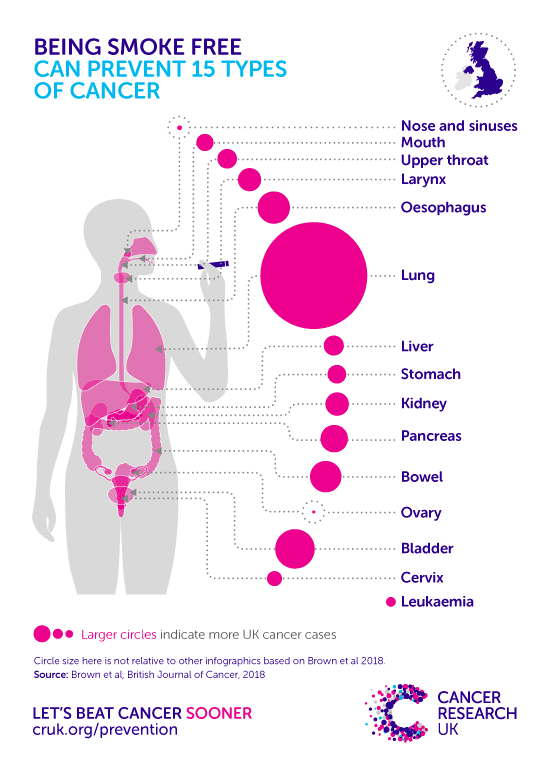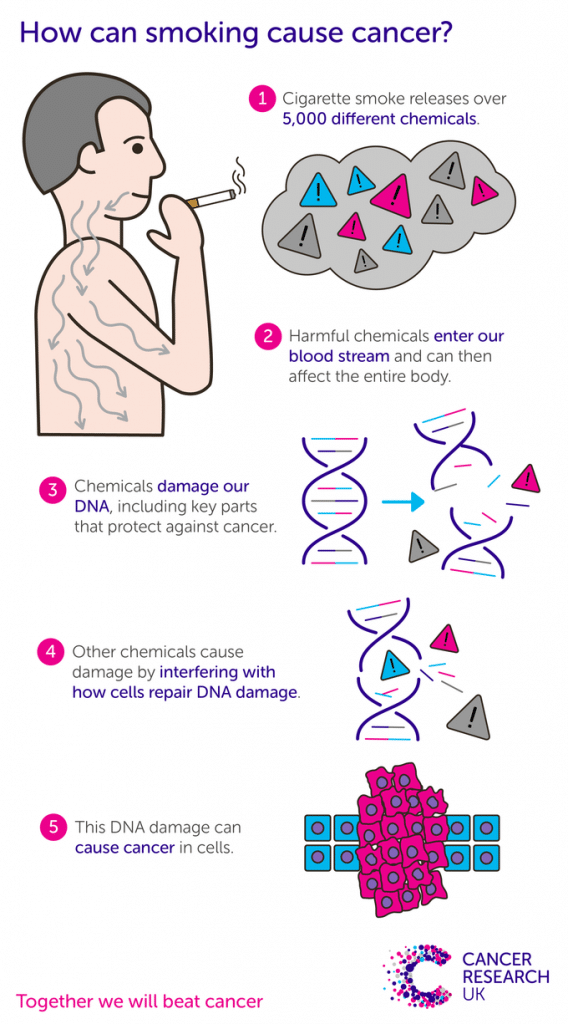Everybody knows that smoking causes cancer – particularly smokers – but do you know which types of cancer are most associated with smoking and how smoking causes cancer?
Smoking causes at least 15 different types of cancer.

Chemicals in tobacco smoke harm the cleaning system that our bodies use to remove toxins, so smokers are less able to handle toxic chemicals than those with healthy lungs and blood.
The DNA in all our cells controls how they behave. If DNA is damaged, things can go wrong. For example, a chemical, benzo(a)pyrene causes damage specifically at a part of the DNA that normally protects our cells from cancer.
The cocktail of chemicals in tobacco smoke is even more dangerous as a mix, because when combined they can make it easier for toxins to ‘stick’ to cells. Here are just a few of the ingredients found in combustible tobacco products, aka cigarettes:3
Acetone—found in nail polish remover
Acetic acid—an ingredient in hair dye
Ammonia—a common household cleaner
Arsenic—used in rat poison
Benzene—found in rubber cement and gasoline
Butane—used in lighter fluid
Cadmium—active component in battery acid
Carbon monoxide—released in car exhaust fumes
Formaldehyde—embalming fluid
Hexamine—found in barbecue lighter fluid
Lead—used in batteries
Naphthalene—an ingredient in mothballs
Methanol—a main component in rocket fuel
Tar—material for paving roads
Toluene—used to manufacture paint
Why don’t people just quit smoking?
Imagine if someone asked you to drink some of these toxins? You’d laugh and walk away, right? Yet every day smokers inhale them straight into their bodies and inflict them on the people around them – passive smoking is also deadly. So, why don’t smokers just stop and avoid all this harm? If it was that easy nobody would be smoking today, but quitting is incredibly hard.
Nicotine is highly addictive (but doesn’t cause cancer) so it’s super hard for a smoker to just put away their pack of cigs and decide to quit. Vaping is now a recognised means of helping smokers quit and it’s also a great way to control the amount of Nicotine you inhale which overtime can help manage the addiction.
While vaping isn’t entirely risk free, it’s 95% less harmful than smoking.1 Within a few days of quitting smoking your body will begin to heal and by the end of the first month the difference is dramatic.
It won’t be news to anyone that the single biggest type of cancer associated with smoking is Lung Cancer. In fact, 7 in 10 lung cancer cases in the UK are directly related to smoking. Lung Cancer is also the most common cause of cancer related death.
It causes other cancers including mouth, pharynx (upper throat), nose and sinuses, larynx (voice box), oesophagus (food pipe), liver, pancreas, stomach, kidney, bowel, ovary, bladder, cervix, and some types of leukaemia.
It may be a surprise to some that it can cause cancer in places like the bladder, or cervix, but the chemicals ingested while smoking are so toxic, they have body wide impact.
The more you smoke the greater risk you are at – obvious stuff, but how does it affect the body to cause cancer?
Quantity smoked is a factor, but how long you smoke is what really heightens the risk. For example, smoking one pack a day for 40 years is even more dangerous than smoking two packs a day for 20 years. The longer you do it, the more chance there is that the cellular changes will result in the formation of an abnormal cancerous cell.4
Why does smoking create so many cancers?
It all comes down to the toxins that are released when tobacco is burned and what those toxins do once inside your body. Research has shown that for every 15 cigarettes smoked, there is a DNA change which could cause a cell in the body to become cancerous. So, smoking is changing your DNA at a cellular level and this is how cancer begins.

We created a programme called Switch To Quit which is designed to help smokers make the switch and beat their smoking habit.
The sooner our world becomes smoke free, the sooner hundreds of thousands of preventable deaths will end.
If you, or someone you know, wants to switch to vaping, but doesn’t know how, contact me and I will help get you/them started on the journey to quit smoking.
BE SAFE OUT THERE.
References
References
-
- McNeill, A. et al. Evidence review of e- cigarettes and heated tobacco products 2018. A report commissioned by Public Health England (2018).
- Andy McEwen and Hayden McRobbie, Electronic cigarettes: A briefing for stop smoking services, National Centre for Smoking Cessation and Training (NCSCT) in association with Public Health England (2016)
- Medical Editorial Content Board, American Cancer Society, ‘Harmful Chemicals in Tobacco’ (2015)
- Cancer Research UK, 2019

Joanne Emmerson FCIM
Head of Marketing, Ibiza Club
Joanne is a fellow of the Royal Chartered Institute of Marketing and has 30+ years marketing experience. She has worked all around the world, is published in 7 countries and teaches marketing communication theory at Post Graduate level both in the UK and USA. She has worked alongside many government bodies, health organisations and national charities. ivcservice@ibizavapeclub.com
